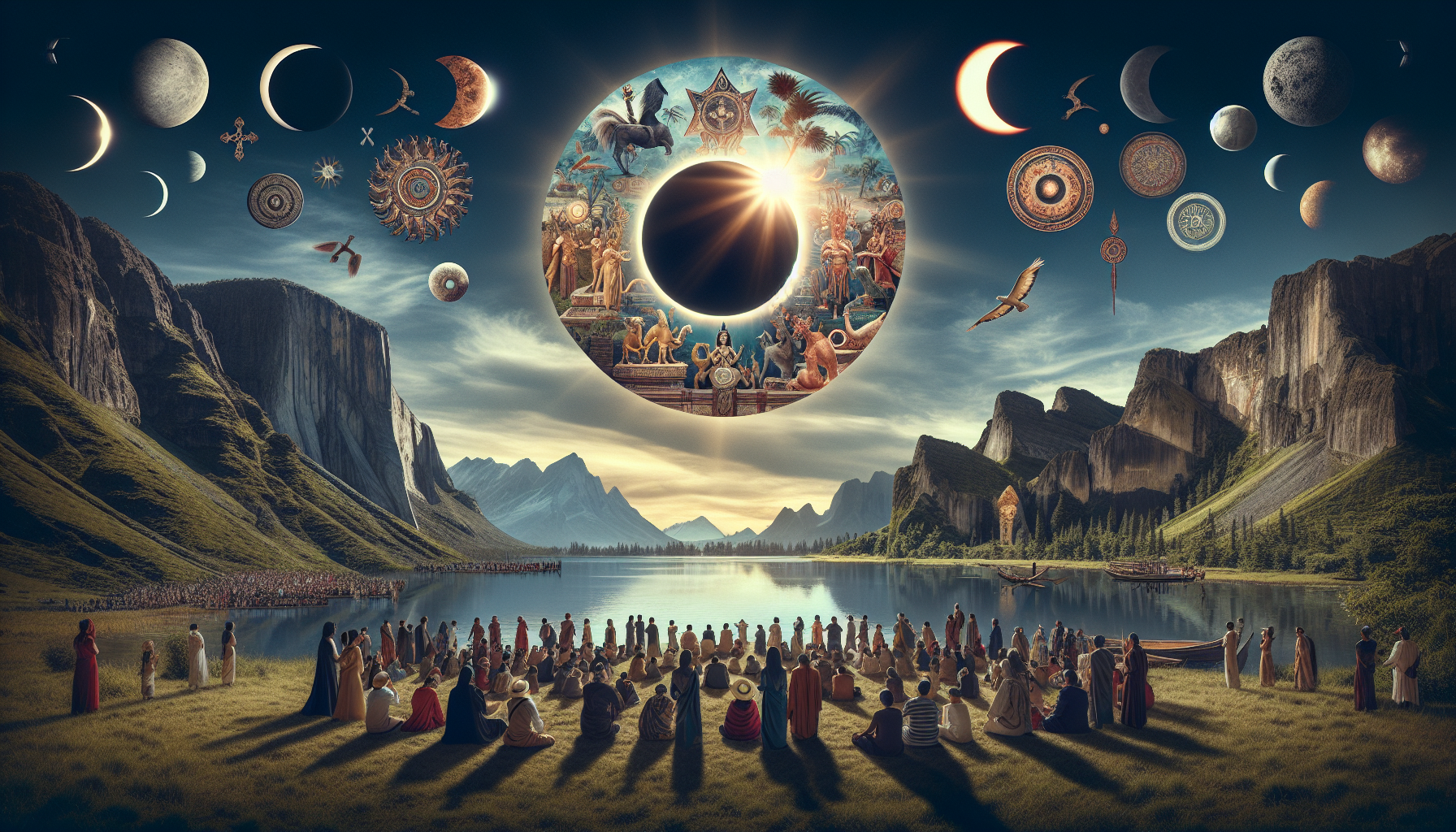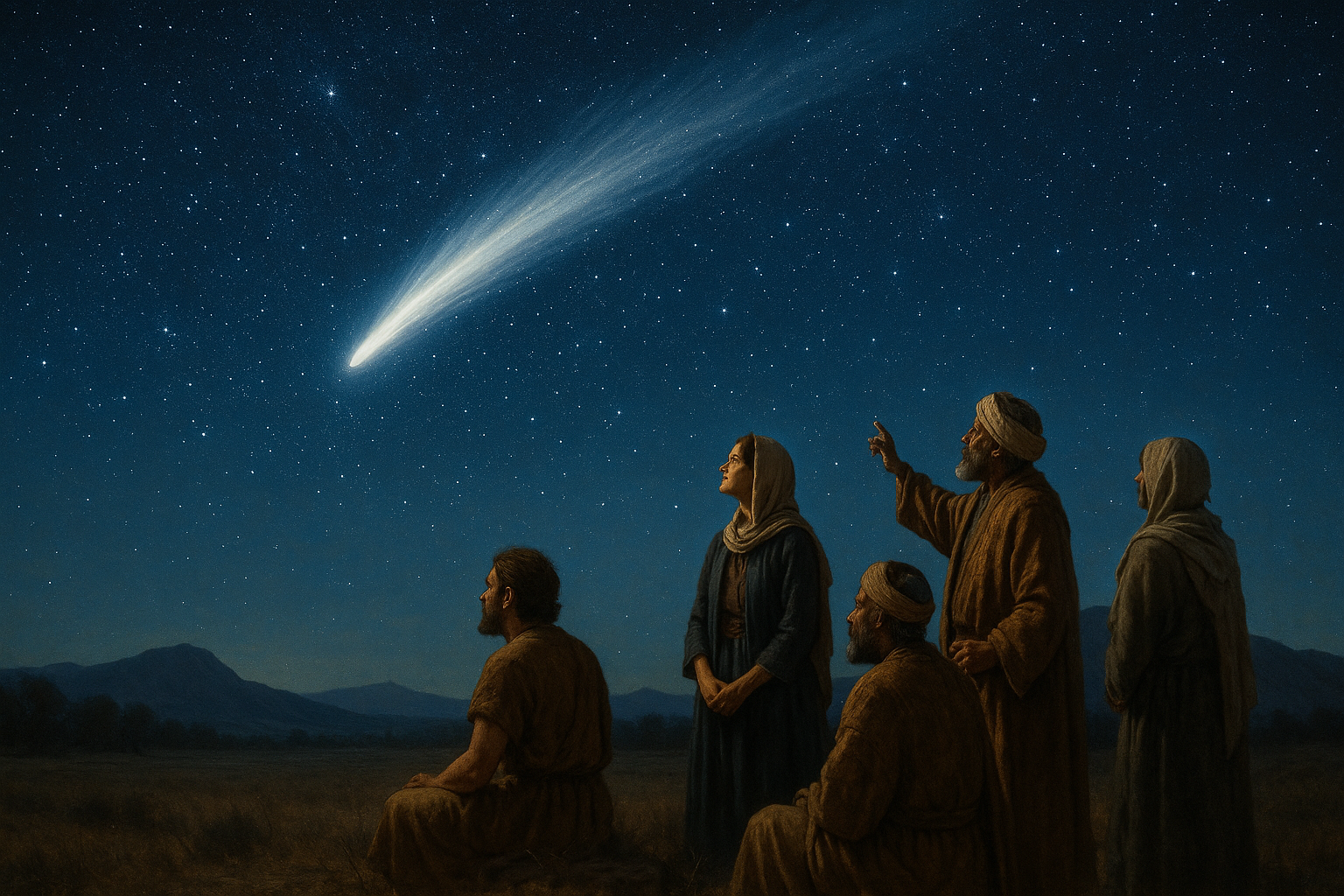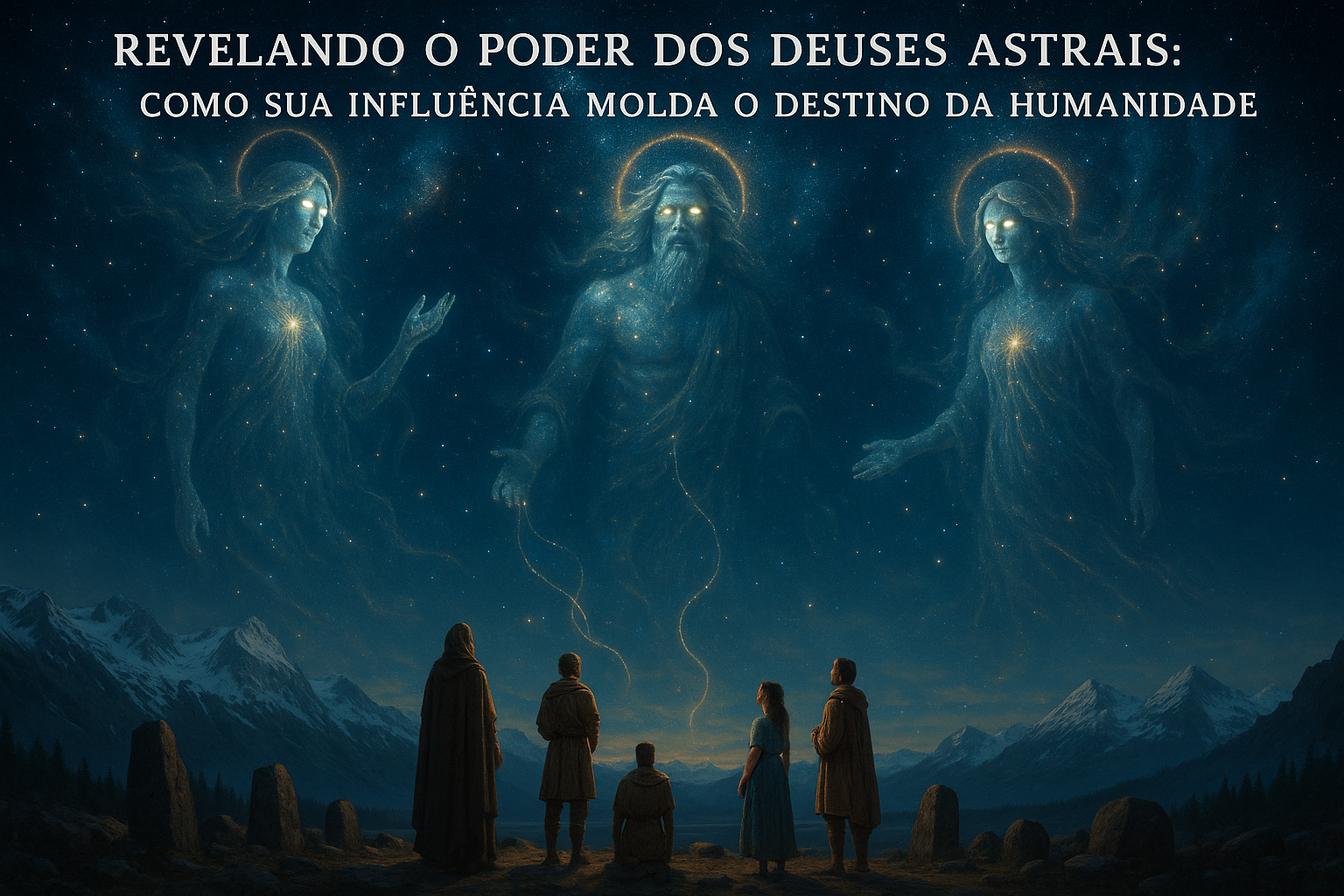In the vast tapestry of celestial phenomena, few events capture human imagination quite like an eclipse. These mesmerizing occurrences, where the sun, moon, and Earth align in a cosmic ballet, have fascinated civilizations for millennia. From ancient lore to modern science, eclipses have been a source of wonder, fear, and inspiration. They serve as a testament to humanity’s enduring quest to understand the universe and our place within it. As we embark on this exploration of mythic interpretations of eclipses, prepare to journey through time and space, uncovering the rich tapestry of stories that have been woven around these celestial wonders. 🌘
Across cultures and centuries, eclipses have inspired a plethora of myths and legends, each attempting to explain the inexplicable. From the Norse myth of wolves chasing the sun and moon, leading to their temporary disappearance, to the ancient Chinese belief in a dragon devouring the sun, these stories reveal not only the creativity of the human spirit but also a universal need to find meaning in the cosmic order. As we delve deeper, we will explore how these narratives not only provided explanations but also reflected societal values, fears, and aspirations. By examining these ancient interpretations, we gain insight into the collective psyche of our ancestors and their relationship with the cosmos.
In this article, we will traverse the globe, from the mysterious rituals of the Maya and the intricate cosmology of Hindu texts, to the symbolic interpretations of eclipses in African and Indigenous American cultures. We will also discuss how these myths have evolved over time, influenced by scientific advancements and cultural exchanges. By weaving together these diverse perspectives, we aim to shed light on the profound impact eclipses have had on human history and consciousness. Whether you’re a seasoned astronomer, a mythology enthusiast, or simply curious about the wonders of the sky, this exploration promises to offer new insights and provoke thoughtful reflection on the mysteries that continue to shape our world. 🌒
The Historical Significance of Eclipses
Eclipses have fascinated humans for millennia, often being interpreted as significant celestial events with deep cultural and spiritual meanings. Historically, many ancient civilizations viewed eclipses as omens or divine messages. For example, the Babylonians were among the earliest to study and document eclipses, using them to refine their astronomical calculations. They believed eclipses were messages from the gods, often predicting the rise and fall of kings or significant political events. Their records helped lay the groundwork for understanding celestial mechanics, but they also imbued these events with a sense of mystery and foreboding.
In ancient China, solar eclipses were thought to be caused by celestial dragons devouring the sun. This interpretation was so ingrained that during an eclipse, people would bang drums and make noise to scare the dragon away. Chinese astronomers, tasked with predicting these events, played a crucial role in maintaining the emperor’s favor. The failure to accurately predict an eclipse could be seen as an omen of misfortune, leading to severe consequences for those involved. This blend of astronomy and mythology highlights the dual role eclipses played in ancient societies: both as phenomena to be understood and as mystical events to be revered.
The Maya civilization, known for its advanced understanding of astronomy, also placed great importance on eclipses. They meticulously recorded celestial events and incorporated them into their calendar systems. The Dresden Codex, one of the few surviving Maya texts, includes an eclipse table used for predicting these events. Eclipses were often linked to rituals and religious ceremonies, illustrating the deep connection between celestial events and societal practices. This relationship between science and spirituality underscores the complexity of eclipse interpretations throughout history.
Impact on Ancient Cultures
Eclipses have long impacted various cultures, influencing their myths, religions, and daily lives. In ancient Greece, philosophers like Anaxagoras sought to explain eclipses through natural phenomena rather than divine intervention. This marked a shift towards a more scientific understanding, yet many still held onto mythological interpretations. The Greek historian Herodotus recounted an eclipse during the Battle of Halys, which was interpreted as a sign to halt the conflict, illustrating the profound influence such events had on human affairs.
Similarly, in India, eclipses were traditionally seen as battles between the gods and demons. According to Hindu mythology, the demon Rahu causes eclipses by swallowing the sun or moon. These stories are reflected in religious texts and continue to influence cultural practices today. For instance, during an eclipse, many Hindus engage in rituals such as fasting and bathing to purify themselves and ward off negative energies. This fusion of myth and tradition showcases the enduring legacy of eclipses in shaping cultural identities and practices.
Eclipses also played a significant role in the Islamic world, where they were studied extensively by scholars like Al-Biruni and Al-Tusi. These astronomers made significant contributions to the understanding of celestial mechanics, using eclipses to refine their models of the solar system. However, eclipses also held spiritual significance, with many Muslim communities viewing them as opportunities for reflection and prayer. The dual nature of eclipses as both scientific phenomena and spiritual events highlights their unique place in human history, bridging the gap between the physical and metaphysical worlds.
Modern Scientific Understanding of Eclipses
With the advancement of science and technology, our understanding of eclipses has evolved significantly. Today, we know that solar eclipses occur when the moon passes between the Earth and the sun, casting a shadow on the Earth. Conversely, lunar eclipses happen when the Earth comes between the sun and the moon, casting a shadow on the moon. This scientific explanation, grounded in the laws of celestial mechanics, demystifies these events but does not diminish their awe-inspiring nature.
Astronomers now use sophisticated equipment to study eclipses, providing valuable data about the sun’s corona, the moon’s surface, and the Earth’s atmosphere. For instance, during a total solar eclipse, the sun’s corona, a hot, outer layer of plasma, becomes visible. This rare opportunity allows scientists to study the corona’s properties, such as its temperature and magnetic fields, which are crucial for understanding solar winds and space weather.
Eclipse studies have also contributed to significant scientific breakthroughs. Albert Einstein’s theory of general relativity was confirmed during a solar eclipse in 1919 when observations showed the bending of light around the sun. This event marked a pivotal moment in modern physics, illustrating the profound impact eclipses can have on scientific advancement.
Eclipse Prediction and Observation
Today, astronomers can predict eclipses with remarkable accuracy using complex mathematical models and computer simulations. These predictions allow scientists and enthusiasts alike to prepare for and observe these celestial events. Organizations like NASA provide detailed eclipse schedules, offering information on the timing and visibility of upcoming eclipses worldwide.
Observing an eclipse is a popular activity, drawing crowds to locations within the path of totality. While total solar eclipses are relatively rare, occurring approximately every 18 months, they provide a unique opportunity for both scientific study and public engagement. During these events, astronomers set up telescopes equipped with specialized filters to capture detailed images of the sun’s corona. Meanwhile, the general public can safely view the eclipse using eclipse glasses or pinhole projectors, ensuring a safe and memorable experience.
For those interested in learning more about eclipses and their scientific significance, the following video offers a comprehensive overview: “Eclipses 101” by National Geographic. Watch this video to deepen your understanding of these fascinating events and their place in our universe.
The Mythic Interpretations of Eclipses in Various Cultures
The allure of eclipses extends beyond scientific curiosity, delving into the realm of mythology and folklore. Throughout history, different cultures have crafted stories and legends to explain these celestial occurrences, imbuing them with mystical significance. These mythic interpretations offer a window into the human psyche, revealing how societies make sense of the unknown and incorporate cosmic events into their worldviews.
In Norse mythology, eclipses are linked to the tale of Sköll and Hati, two wolves that chase the sun and moon across the sky. According to legend, an eclipse occurs when these wolves catch and devour their celestial prey, only to release them shortly after. This story highlights the Norse belief in the cyclical nature of time and the inevitability of cosmic events, reflecting their understanding of the world as a series of interconnected cycles.
Native American tribes also have rich traditions surrounding eclipses. The Navajo people, for example, view eclipses as times of balance and renewal. They believe that the sun and moon are temporarily restoring harmony to the world, and as such, they refrain from looking at the eclipse, engaging instead in meditation and reflection. This perspective emphasizes the interconnectedness of the cosmos and the importance of maintaining balance in all aspects of life.
In contrast, the Inca civilization saw eclipses as expressions of divine wrath. They believed that an eclipse signaled the anger of the gods, prompting the need for rituals and sacrifices to appease them. This interpretation underscores the power of myth in shaping cultural practices and societal responses to natural events. By exploring these diverse mythic interpretations, we gain insight into the rich tapestry of human belief and the enduring influence of eclipses on our collective consciousness.
The Role of Eclipses in Mythology and Religion
Eclipses have played a significant role in various religious traditions, often serving as symbols of divine intervention or cosmic balance. In many cultures, eclipses are seen as manifestations of the struggle between good and evil, light and darkness, or life and death. These themes resonate deeply within the human experience, offering a framework for understanding the complexities of existence and the mysteries of the universe.
In Christianity, eclipses have been associated with significant events in biblical history. Some interpretations suggest that the darkness during Christ’s crucifixion was caused by an eclipse, symbolizing the triumph of darkness over light. This interpretation reflects the Christian belief in the cyclical nature of life and the eventual victory of good over evil. Similarly, in Islam, eclipses are viewed as signs of Allah’s power and a reminder of human mortality, prompting reflection and prayer.
The role of eclipses in mythology and religion extends to the present day, influencing modern spiritual practices and beliefs. Many contemporary spiritual movements draw on ancient myths and traditions, incorporating eclipses into their rituals and ceremonies. This enduring connection between eclipses and spirituality highlights the timeless appeal of these celestial events, offering a bridge between the past and present, the scientific and the mystical.
Understanding the Psychological Impact of Eclipses
Beyond their scientific and mythological significance, eclipses also have a profound psychological impact on individuals and communities. The sudden transformation of day into night or the temporary dimming of the moon can evoke a range of emotions, from awe and wonder to fear and anxiety. These emotional responses are deeply rooted in the human experience, reflecting our innate curiosity and desire to understand the world around us.
Research suggests that eclipses can influence human behavior and perception, affecting mood, cognition, and decision-making processes. The rarity and unpredictability of these events can create a sense of excitement and anticipation, leading to heightened arousal and attentional focus. This increased state of alertness can enhance cognitive performance, fostering creativity and problem-solving abilities.
However, eclipses can also trigger anxiety and stress, particularly for individuals with a predisposition towards fear of the unknown. The dramatic alteration of familiar environmental cues can disrupt cognitive processing, leading to feelings of disorientation and uncertainty. These psychological effects underscore the complex interplay between perception, emotion, and cognition, highlighting the intricate relationship between celestial events and human psychology.
Exploring the Emotional and Cultural Reactions to Eclipses
Eclipses evoke diverse emotional and cultural reactions, shaped by individual experiences and societal norms. In some cultures, eclipses are celebrated as opportunities for communal gathering and reflection, fostering a sense of unity and shared experience. These events can serve as catalysts for social interaction and cultural expression, reinforcing community bonds and collective identity.
Conversely, in cultures where eclipses are viewed as omens or signs of impending doom, these events may elicit fear and apprehension. The belief in the malevolent influence of eclipses can lead to anxiety and avoidance behaviors, impacting social dynamics and individual well-being. Understanding these varied responses can provide valuable insights into the cultural and psychological dimensions of eclipses, informing strategies for promoting positive engagement and mitigating negative effects.
For a deeper exploration of the psychological impact of eclipses, consider watching this insightful video: “The Psychology of Eclipses” by Science Studio. This resource offers a comprehensive analysis of the emotional and cognitive effects of eclipses, enhancing our understanding of their complex influence on human behavior.
The Future of Eclipse Studies
As technology continues to advance, the study of eclipses is poised to enter a new era of discovery and innovation. Modern tools and techniques are enabling scientists to explore eclipses with unprecedented precision, unlocking new insights into the dynamics of our solar system and the fundamental processes governing celestial bodies. These advancements are paving the way for a deeper understanding of eclipses and their potential applications in fields ranging from astronomy and physics to environmental science and technology.
One promising area of research is the use of eclipses to study exoplanets and other distant celestial objects. By observing the effects of eclipses on distant stars, scientists can infer the presence of orbiting planets and gather data on their characteristics, such as size, composition, and atmospheric conditions. This information is crucial for identifying potentially habitable worlds and understanding the diversity of planetary systems in our galaxy.
Another exciting development is the application of eclipse data in climate science. By analyzing the changes in atmospheric conditions during an eclipse, researchers can gain valuable insights into the Earth’s climate system, including the behavior of clouds, aerosols, and radiation. This information can inform climate models and improve our ability to predict and respond to global environmental challenges.
Innovations in Eclipse Observation and Technology
The future of eclipse studies is also being shaped by innovations in observation technology and data analysis. Advances in imaging and spectroscopy are enabling scientists to capture detailed, high-resolution data on the sun’s corona, providing new insights into its complex dynamics and behavior. These technologies are also enhancing our ability to study the moon’s surface and composition, revealing new information about its geological history and evolution.
In addition to traditional observation methods, new approaches are being developed to engage the public in eclipse studies. Citizen science initiatives, such as the Global Eclipse Observation Network, are empowering individuals to contribute to scientific research by collecting and sharing data on eclipses. These collaborative efforts are expanding the scope of eclipse studies and fostering a greater appreciation for the scientific and cultural significance of these events.
The future of eclipse studies is bright, with exciting opportunities for discovery and exploration on the horizon. As we continue to unlock the mysteries of eclipses, we deepen our understanding of the cosmos and our place within it, inspiring new generations of scientists and enthusiasts to explore the wonders of the universe.

Conclusion
**Conclusion: Unveiling the Mysteries of Eclipses**
As we draw this exploration of mythic interpretations of eclipses to a close, we can appreciate the profound impact these celestial events have had on cultures throughout history. From ancient civilizations to modern societies, eclipses have stirred the human imagination, prompting a myriad of interpretations that reflect our endless curiosity about the cosmos and our place within it.
The article began by delving into the historical significance of eclipses across different cultures. We examined how ancient civilizations, such as the Babylonians and the Chinese, meticulously observed these celestial phenomena, often interpreting them as omens or divine messages. These societies demonstrated a remarkable ability to predict eclipses with impressive accuracy, merging astronomical observations with mythological narratives.
Moving forward, we explored the rich tapestry of myths surrounding eclipses. In many cultures, eclipses were seen as cosmic battles or divine interventions. The Norse mythology, for example, depicted wolves devouring the sun or moon, while Hindu myths described the demon Rahu causing the celestial cover-up. These stories, while varied, underscore a common theme: the struggle between light and darkness, good and evil, order and chaos.
In modern times, eclipses continue to captivate the human spirit, albeit through a different lens. Science has demystified many of the fears associated with these events, transforming them into opportunities for education and communal gatherings. Solar and lunar eclipses now attract thousands of spectators worldwide, eager to witness the awe-inspiring alignment of celestial bodies.
The journey through these mythic interpretations not only enriches our understanding of eclipses but also highlights the universal human desire to comprehend the unknown. This exploration invites us to reflect on how myths have shaped human culture, providing a framework to interpret the mysteries of the universe. Such narratives remind us of our shared humanity and the timeless connection we have with the cosmos.
As we conclude, the importance of understanding these mythic interpretations becomes evident. They offer us valuable insights into the ways our ancestors perceived the universe, blending science, spirituality, and creativity. By studying these interpretations, we gain a deeper appreciation for the cultural heritage that has been passed down through generations.
I encourage you, dear reader, to share this newfound knowledge with others. Whether through discussions, social media, or personal reflection, spreading awareness about the mythic interpretations of eclipses can foster a greater appreciation for the wonders of our universe. Furthermore, consider how these stories can inspire us in our contemporary lives, prompting us to look beyond the surface and seek meaning in the celestial dance that unfolds above us.
Let’s continue to embrace the mystery and magic of eclipses, recognizing them not only as astronomical events but as gateways to understanding the enduring human spirit. Thank you for joining this exploration, and may your curiosity about the universe continue to shine brightly. 🌟
For further reading and exploration on this topic, here are some active and reputable sources you might find enlightening:
– Time and Date’s Guide to Eclipses
– The American Astronomical Society’s Eclipse Resource
By diving deeper into these resources, you’ll find a wealth of information that further illuminates the complex interplay between science, myth, and cultural interpretation. Let the journey of discovery continue!
Toni Santos is a visual storyteller and cosmic interpreter whose work illuminates the ancient skywatchers and their prehistoric astronomy—the profound ways early humans observed and revered the heavens before written history. Through a visionary lens, Toni explores how the stars, planets, and celestial cycles shaped myth, ritual, and survival in cultures lost to time.
Rooted in a fascination with archaic observatories, stone alignments, and celestial symbolism, Toni’s creative journey reveals the deep human impulse to understand and harmonize with the cosmos. From lunar phases guiding planting seasons to the sacred paths of the Milky Way, each of his works embodies the awe and knowledge encoded in the night sky.
Combining artistic craftsmanship with archaeological insight, Toni’s pieces evoke the mystery and precision of prehistoric astronomers. His work does more than depict—it channels the timeless dance between earth and sky, bridging ancient wisdom with contemporary wonder.
As the visionary behind Vizovex, Toni shares curated visuals, essays, and symbolic studies that invite others to reconnect with the cosmic heritage written in stone and starlight. His creations are a call to look upward, to listen to the silent stories told by the stars, and to honor the first astronomers who mapped the heavens with reverence and ingenuity.
His work is a tribute to:
The celestial wisdom of prehistoric peoples
The sacred geometry of ancient observatories
The enduring bond between human culture and the cosmos
Whether you’re a stargazer, a scholar of ancient mysteries, or someone captivated by the universe’s earliest storytellers, Toni welcomes you to journey through a space where the sky is both map and myth—one constellation, one ritual, one revelation at a time.




